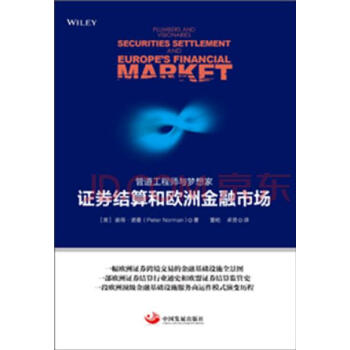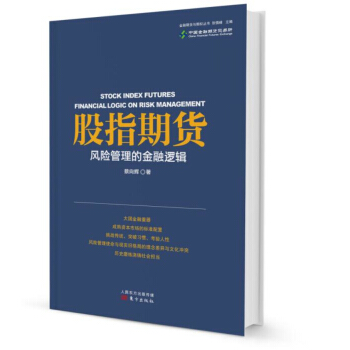![随机波动金融市场衍生品 [Derivatives in Financial Markets with Stochasic Volatility]](https://pic.windowsfront.com/10104531/33317e12-0627-4a09-ae0f-77adb3601423.jpg)

具体描述
内容简介
This book addresses problems in financial mathematics of pricing and hedging derivative securities in an environment of uncertain and changing market volatility. These problems are important to investors ranging from large trading institutions to pension funds. The authors present mathematical and statistical tools that exploit the "bursty" nature of market volatility. The mathematics is introduced through examples and illustrated with simulations, and the approach described is validated and tested on market data.The material is suitable for a one-semester course for graduate students who have been exposed to methods of stochastic modeling and arbitrage pricing theory in finance. It is easily accessible to derivatives practitioners in the inancial engineering industry.
内页插图
目录
Introduction1 The Black-Scholes Theory of Derivative Pricing
1.1 Market Model
1.1.1 Brownian Motion
1.1.2 Stochastic Integrals
1.1.3 Risky Asset Price Model
1.1.4 Itos Formula
1.1.5 Lognormal Risky Asset Price
1.2 Derivative Contracts
1.2.1 European Call and Put Options
1.2.2 American Options
1.2.3 Other Exotic Options
1.3 Replicating Strategies
1.3.1 Replicating Self-Financing Portfolios
1.3.2 The Black-Scholes Partial Differential Equation
1.3.3 Pricing to Hedge
1.3.4 The Black-Scholes Formula
1.4 Risk-Neutral Pricing
1.4.1 Equivalent Martingale Measure
1.4.2 Self-Financing Portfolios
1.4.3 Risk-Neutral Valuation
1.4.4 Using the Markov Property
1.5 Risk-Neutral Expectations and Partial Differential Equations
1.5.1 Infinitesimal Generators and Associated Martingales
1.5.2 Conditional Expectations and Parabolic Partial Differential Equations
1.5.3 Application to the Black-Scholes Partial Differential Equation
1.5.4 American Options and Free Boundary Problems
1.5.5 Path-Dependent Derivatives
1.6 Complete Market
2 Introduction to Stochastic Volatility Models
2.1 Implied Volatility and the Smile Curve
2.1.1 Interpretation of the Smile Curve
2.1.2 What Data to Use
2.2 Implied Deterministic Volatility
2.2.1 Time-Dependent Volatility
2.2.2 Level-Dependent Volatility
2.2.3 Short-Time Tight Fit versus Long-Time Rough Fit
2.3 Stochastic Volatility Models
2.3.1 Mean-Reverting Stochastic Volatility Models
2.3.2 Stock-Price Distribution under Stochastic Volatility
2.4 Derivative Pricing
2.5 Pricing with Equivalent Martingale Measures
2.6 Implied Volatility as a Function of Moneyness
2.7 Market Price of Volatility Risk and Data
2.8 Special Case: Uncorrelated Volatility
2.8.1 Hull-White Formula
2.8.2 Stochastic Volatility Implies Smile
2.8.3 Remark on Correlated Volatility
2.9 Summary and Conclusions
3 Scales in Mean-Reverting Stochastic Volatility
3.1 Scaling in Simple Models
3.2 Models of Clustering
3.2.1 Example: Markov Chain
3.2.2 Example: Another Jump Process
3.2.3 Example: Ornstein-Uhlenbeck Process
3.2.4 Summary
3.3 Convergence to Black-Scholes under Fast Mean-Reverting Volatility
3.4 Scales in the Returns Process
3.4.1 The Returns Process
3.4.2 Returns Process with Jump Volatility
3.4.3 Returns Process with OU Volatility
3.4.4 S&P; 500 Returns Process
4 Tools for Estimating the Rate of Mean Reversion
4.1 Model and Data
4.1.1 Mean-Reverting Stochastic Volatility
4.1.2 Discrete Data
4.2 Variogram Analysis
4.2.1 Computation of the Variogram
4.2.2 Comparison and Sensitivity Analysis with Simulated Data
4.2.3 The Day Effect
4.3 Spectral Analysis
5 Asymptotics for Pricing European Derivatives
5.1 Preliminaries
5.1.l The Rescaled Stochastic Volatility Model
5.1.2 The Rescaled Pricing Equation
5.1.3 The Operator Notation
5.2 The Formal Expansion
5.2.1 The Diverging Terms
5.2.2 Poisson Equations
5.2.3 The Zero-Order Term
5.2.4 The First Correction
5.2.5 Universal Market Group Parameters
5.2.6 Probabilistic Interpretation of the Source Term
5.2.7 Put-Call Parity
5.2.8 The Skew Effect
5.3 Implied Volatilities and Calibration
5.4 Accuracy of the Approximation
5.5 Region of Validity
6 Implementation and Stability
6.1 Step-by-Step Procedure
6.2 Comments about the Method
6.3 Dividends
6.4 The Second Correction
7 Hedging Strategies
7.1 Black-Scholes Delta Hedging
7.1.1 The Strategy and Its Cost
7.1.2 Averaging Effect
7.2 Mean Self-Financing Hedging Strategy
7.3 Staying Close to the Price
8 Application to Exotic Derivatives
8. l European Binary Options
8.2 Barrier Options
8.3 Asian Options
9 Application to American Derivatives
9.1 American Problem under Stochastic Volatility
9.2 Stochastic Volatility Correction for an American Put
9.2.1 Expansions
9.2.2 First Approximation
9.2.3 The Stochastic Volatility Correction
9.2.4 Uncorrelated Volatility
9.2.5 Probabilistic Representation
9.3 Numerical Computation
9.3.1 Solution of the Black-Scholes Problem
9.3.2 Computation of the Correction
10 Generalizations
10.1 Portfolio Optimization under Stochastic Volatility
10.1.1 Constant Volatility Merton Problem
10.1.2 Stochastic Volatility Merton Problem
10.1.3 A Practical Solution
10.2 Periodic Day Effect
10.3 Other Markovian Volatility Models
10.3.1 Markovian Jump Volatility Models
10.3.2 Pricing and Asymptotics
10.4 Martingale Approach
10.4.1 Main Argument
10.4.2 Decomposition Result
10.4.3 Comparison with the PDE Approach
10.5 Non-Markovian Models of Volatility
10.5.1 Setting: An Example
10.5.2 Asymptotics in the Non-Markovian Case
10.6 Multidimensional Models
11 Applications to Interest-Rate Models
11.1 Bond Pricing in the Vasicek Model
11.1.1 Review of the Constant Volatility Vasicek Model
11.1.2 Stochastic Volatility Vasicek Models
11.2 Bond Option Pricing
11.2.1 The Constant Volatility Case
11.2.2 Correction for Stochastic Volatility
11.2.3 Implications
11.3 Asymptotics around the CIR Model
11.4 Illustration from Data
11.4.1 Variogram Analysis
11.4.2 Yield Curve Fitting
Bibliography
Index
精彩书摘
The Black-Scholes model rests upon a number of assumptions that are,to some extent.“counterfactual.”Among these are continuity ofthe stock. price process it does not iump),the ability to hedge continuously without transaction costs,inde-pendent Gaussian returns. and constant volatility.We shall focus here on relaxing the last assumption by allowing volatility to vary randomly,for the following rea-son:a well. known discrepancy between Black-Scholes-predicted European op-tion prices and market-traded options prices,the smile curve,can be accounted for by stochastic volatility models. That iS.this modification of the Black-Scholes theory has a posteriori success in one area where the classical model fails.In fact.modeling volatility as a stochastic process iS motivated a priori by em-pirical studies of stock.price returns in which estimated volatility iS observed to exhibit“random”characteristics.Additionally,the effects of transaction costs show up. under many models,as uncertainty in the volatility;fat-tailed returns distributions can be simulated by stochastic volatility;and market‘jump”phe-nomena are often best modeled as volatility iump processes.Stochastic volatility modeling therefore iS not iust a simple fix to one particular Biacl(Scholes as-sumption but rather a powerful modification that describes a much more complex market.We cite literature that explores possible causes of stochastic volatility in the notes at the end Of this chapter. In Chapter 1,we introduced the notation and tools for pricing and hedging deriv-ative securities ander a constant volatility lognormal model(1.2).This iS the sim-plest example of pricing in a complete market.However,pricing in a market with stochastic volatility is an incomplete markets problem.a distinction that(as we shall explain)has far-reaching consequences-particularly for the hedging prob-lem and the problem of parameter estimation. It iS the latter inverse problem that iS the biggest mathematical and practical challenge introduced by such models,and also perhaps the one that benefits most from the asymptotic methods of Chapter 5.前言/序言
用户评价
我是一名对金融领域有着浓厚兴趣的在校学生,在学习经济学和金融学的过程中,衍生品一直是让我感到既好奇又有些畏惧的课题。尤其是“随机波动”这个概念,在很多文献中被反复提及,却往往伴随着复杂的数学公式和抽象的理论,让我难以真正抓住其精髓。当我看到这本书的书名时,我立刻被它吸引了。它似乎承诺了一个能够深入浅出地讲解这一复杂领域的机会。我希望这本书能够帮助我理解,在真实的金融市场中,价格的变动为何会呈现出“随机波动”的特征,这种波动性是如何被度量的,以及它对金融衍生品的价格究竟会产生怎样的影响。同时,我也期待书中能够详细介绍几种常见的金融衍生品,比如期权、期货、掉期等,并解释它们的基本构造、交易机制以及它们与标的资产之间的关系。最关键的是,我希望这本书能够清晰地阐述如何将“随机波动”的概念融入到这些衍生品的定价模型中。我是否能够通过这本书,理解Black-Scholes模型及其局限性,以及其他更复杂的随机波动模型是如何克服这些局限性的?我希望这本书能够为我提供坚实的理论基础,并引导我思考如何在实际的金融市场分析和投资决策中运用这些知识,让我能够对那些充满不确定性的市场有更清晰的认知和更有效的应对策略。
评分这本书的书名, “随机波动金融市场衍生品”,听起来就充满了深度和挑战。我一直对金融市场感到着迷,特别是那些能够帮助人们在不确定性中寻找确定性的工具。衍生品无疑是其中的佼佼者。然而,我也深知,金融市场的波动性是极其复杂的,并非简单的线性变化,而是充满了“随机”的特征。因此,这本书能够将“随机波动”和“衍生品”这两个概念紧密结合,让我感到非常兴奋。我希望这本书能够为我揭示,金融市场的价格变动为何会呈现出“随机”的特性,这种随机性是如何被量化和建模的。更重要的是,我希望能够理解,这些随机波动模型是如何被应用于金融衍生品的定价和风险管理的。 例如,当市场波动性很高时,期权的价格会如何变化?如何利用这些模型来预测并对冲潜在的风险? 我期待这本书能够提供清晰的解释和严谨的数学推导,但又希望它能够以一种能够被非专业读者理解的方式呈现,或者至少能够提供足够的背景知识和解释,让我能够逐步跟上。 我希望通过阅读这本书,能够对金融衍生品有一个更深刻的认识,并理解它们在现代金融体系中扮演的关键角色,以及科学家们是如何通过复杂的数学工具来驾驭市场的不确定性的。
评分我对于能够深刻理解金融市场运作背后逻辑的理论书籍有着天然的偏好。虽然我对金融衍生品已经有所了解,但关于“随机波动”这一概念的深入分析,以及它如何影响衍生品定价和风险管理,一直是我希望进一步探索的领域。这本书的书名直接击中了我的兴趣点。我希望这本书不仅仅是简单地介绍衍生品的种类和交易规则,而是能够深入到金融市场的微观层面,解释为何市场的价格波动往往呈现出“随机”的特性,以及这种特性是如何被数学模型捕捉和刻画的。我特别期待书中能够详细阐述各种随机波动模型(如GARCH模型、随机波动率模型等)的数学原理、推导过程以及它们在实际应用中的优势和局限性。同时,我也希望这本书能够探讨,在存在随机波动的情况下,如何进行有效的风险对冲和资产定价。例如,如果市场波动性本身也在不断变化,那么传统的静态对冲策略是否仍然有效?如何构建能够适应随机波动的动态对冲策略?我希望这本书能够为我提供一种新的视角来审视金融衍生品,并引导我思考如何在充满不确定性的市场环境中做出更明智的决策,从而真正理解金融市场的复杂性和衍生品的价值所在。
评分我一直对金融衍生品的世界充满好奇,尤其是它们如何应对金融市场中普遍存在的“随机波动”。这本书的书名,“随机波动金融市场衍生品”,正是我一直在寻找的那种能够深入解析这一核心问题的书籍。在我看来,金融市场的价格变动并非一成不变,而是充满了各种难以预测的因素,形成了一种“随机波动”的模式。而衍生品,就像是为应对这种不确定性而设计的工具。我期待这本书能够详细阐释“随机波动”究竟意味着什么,以及它在金融市场中是如何表现出来的。更重要的是,我希望书中能够解释,为何传统的金融定价模型在处理随机波动时会显得力不从心,以及如何通过更高级的数学模型(如各种随机波动模型)来捕捉和量化这种波动性。我也对书中关于衍生品定价的部分充满期待。我希望能够理解,在存在随机波动的情况下,期权、期货、掉期等衍生品是如何被定价的,以及这些模型如何帮助交易者进行风险管理和套期保值。我期待这本书能提供一些具体的案例分析,通过实际的例子来展示这些理论在实践中的应用,从而让我能够更直观地理解金融衍生品的复杂性和它们在金融市场中的重要作用。
评分市场上关于金融衍生品的书籍并不少见,但很少有书籍能够如此直观地将“随机波动”这一核心概念与衍生品的分析联系起来。这让我对这本书充满了期待。我一直认为,金融市场的魅力就在于它的不确定性,而衍生品则是人们试图理解和驾驭这种不确定性的智慧结晶。我希望这本书能够深入浅出地解释,为什么金融市场的价格运动会呈现出“随机波动”的特征,这种波动性是如何被量化的,以及它对金融衍生品的定价和风险管理产生怎样的影响。我期待书中能够介绍一些经典的随机波动模型,例如Heston模型,并且解释这些模型是如何捕捉资产价格的波动率本身也是一个随机过程的。同时,我也希望这本书能够涵盖不同类型的金融衍生品,并阐述如何利用随机波动模型来对这些衍生品进行估值。例如,对于期权来说,波动率是影响其价格的关键因素,那么随机波动率模型又会如何改变期权的定价结果呢?我希望这本书能够提供一些实际的应用案例,通过具体的数值例子或者图表来展示这些理论概念是如何在实际操作中应用的,让我能够更直观地理解这些复杂的数学模型所带来的实际意义。
评分作为一名对金融市场有着强烈求知欲的读者,我经常被那些能够揭示市场深层机制的书籍所吸引。这本书的书名, “随机波动金融市场衍生品”,立刻引起了我的注意,因为它直接触及了金融市场最核心的难题之一:预测的困难性以及价格的非线性运动。 我对“随机波动”这个概念的背后逻辑充满好奇。它是否意味着市场价格的变动是完全不可预测的?还是说,虽然存在随机性,但其背后仍然遵循着一定的统计规律,而这些规律可以通过数学模型来捕捉? 我希望这本书能够从基础概念讲起,逐步深入到如何利用随机波动模型来分析和定价金融衍生品。 我期待书中能够解释,为什么传统的金融模型(例如,假设价格服从对数正态分布)在描述实际市场时存在不足,以及随机波动模型是如何克服这些不足的。 此外,我也对这本书在应用层面上的阐述抱有很高的期望。 它是否能够通过具体的案例,比如股票期权、利率掉期等,来展示随机波动模型在实际定价、风险管理和投资组合构建中的应用? 我希望这本书能够让我不仅仅停留在理论层面,而是能够更深入地理解这些复杂的金融工具在真实市场中的运作方式,以及它们如何帮助投资者应对市场的不可预测性。
评分对于这本书的购买,我几乎是出于一种强烈的好奇心驱动。一直以来,金融衍生品对我来说都是一个既熟悉又陌生的概念。在新闻报道中,我经常会听到关于期权、期货、掉期等等词汇,它们似乎与股价的涨跌、汇率的变动、大宗商品的交易紧密相连,但其具体的运作机制却始终笼罩着一层迷雾。我尤其对“随机波动”这个术语感到好奇。在我们的日常生活中,我们习惯于看到一些事物在一定的范围内变化,但金融市场似乎更加复杂,它的波动往往是难以捉摸的,甚至可以说是“随机”的。这本书的书名直接点明了这两大核心概念,这让我觉得它很可能是我打破认知壁垒的钥匙。我希望通过阅读这本书,能够理解这些衍生品是如何被构建出来的,它们的定价模型又是如何运作的,以及它们在实际的金融交易中扮演着怎样的角色。更重要的是,我希望能理解“随机波动”这一概念是如何被纳入到金融模型中的,以及它如何影响着衍生品的价值和风险。作为一个对数学和统计学有一定基础的读者,我期待书中能够有一定程度的数学推导,但又希望这些推导不会过于晦涩,能够用清晰的逻辑和解释引导我理解其中的奥秘。我对这本书的期望是,它能为我勾勒出一幅清晰的金融衍生品世界的图景,让我能够在这个复杂系统中找到一些清晰的脉络,理解那些在幕后运作的复杂机制。
评分作为一名在金融行业工作多年的从业者,虽然日常工作中会接触到各种金融产品,但对于金融衍生品背后的深层理论,尤其是“随机波动”这个概念的数学建模和应用,我始终觉得还有深入学习的空间。我一直在寻找一本能够系统梳理并深入讲解这些内容的专业书籍。这本书的书名“随机波动金融市场衍生品”恰好点中了我的需求。我希望这本书能够在我已有的实践经验之上,为我提供更扎实的理论支撑。我期待书中能够详细介绍各种随机波动模型的构建原理、数学推导过程以及它们在不同市场环境下的适用性。例如,我希望能理解局部随机波动模型、随机波动率模型等之间的区别和联系,以及它们是如何被用来更精确地描述市场价格动态的。同时,我也希望书中能够涵盖如何利用这些模型进行衍生品的定价、风险对冲以及投资策略的设计。我尤其关注的是,这本书是否能提供一些前沿的研究进展或者实证分析,来验证这些理论模型的有效性。我希望通过阅读这本书,能够进一步提升我对金融衍生品的理解深度,从而在我的工作中能够更自信地运用这些工具,做出更明智的决策,更好地把握市场机遇,规避潜在风险。
评分这本书的封面设计就散发着一种严谨而专业的学术气息,深邃的蓝色背景搭配着银色印刷的标题,仿佛预示着即将进入一个充满复杂而又迷人的金融世界。我在书店里随意翻阅,目光被“随机波动”和“衍生品”这两个词吸引住了。我一直对金融市场充满好奇,尤其对那些能够预测和对冲风险的工具感到着迷。虽然我不是金融领域的专业人士,但作为一个对经济运行原理感兴趣的普通读者,我希望能通过这本书,初步了解这些看似高深莫测的金融衍生品是如何在波诡云谲的市场中发挥作用的。我期待这本书能够用一种相对易懂的方式,为我揭示金融衍生品的神秘面纱,让我理解它们是如何被创造出来,又是如何被用来管理风险,甚至如何可能创造财富的。同时,我也很好奇“随机波动”这个概念在其中扮演着怎样的角色。在现实世界中,市场的价格变动往往不是线性的、可预测的,而是充满了不确定性和突发性,这种“随机性”是如何被量化和建模的呢?这本书能否让我对这种不确定性有更深刻的认识,并理解金融工程师们是如何在这种不确定性中寻找规律的?我希望这本书不仅仅停留在理论层面,也能有一些实际的应用案例或者思考,让我能够将书中的知识与现实世界的金融新闻联系起来,从而更好地理解我们每天都能接触到的金融市场。总的来说,这本书的外在表现给我留下了深刻的第一印象,激发了我深入探索金融衍生品世界的强烈愿望,我希望能从中获得启发和知识。
评分拿到这本书,我并没有急于翻开第一页,而是仔细品味了书名和副标题。 “随机波动金融市场衍生品”——这个书名本身就充满了挑战和吸引力。我一直在思考,是什么样的力量让金融市场如此难以预测?又是什么样的金融工具能够捕捉并利用这种“随机波动”?在我个人的理解中,金融市场就好比大海,而价格的波动就是海浪,时而平静,时而汹涌,充满了变数。衍生品,或许就是那些能够“驾驭”海浪的船只,它们能够帮助人们在波涛汹涌的市场中航行,规避风险,甚至捕获机遇。 我对书中关于“随机波动”部分的介绍充满了期待。它是否会解释为什么市场的波动性本身也是波动的?例如,在某些时期,市场可能相对稳定,而在另一些时期,则会剧烈震荡。这种波动性的变化,又该如何被建模和预测?我希望这本书能够从基本概念入手,循序渐进地介绍一些经典的随机波动模型,并阐述它们是如何被应用于衍生品的定价和风险管理的。同时,我也希望书中能包含一些实际的案例分析,通过具体的例子来展示这些理论是如何在现实世界中发挥作用的。我希望这本书能够让我不仅理解“是什么”,更能理解“为什么”和“怎么做”,从而对金融衍生品有一个更全面、更深入的认识,也能让我从一个旁观者的角度,对金融市场的复杂性有一个更深刻的体会。
评分1.1.1 Brownian Motion
评分1.5.4 American Options and Free Boundary Problems
评分书写得很好,只是略感觉单薄
评分1.2.1 European Call and Put Options
评分1.1 Market Model
评分1.1.3 Risky Asset Price Model
评分1.4.1 Equivalent Martingale Measure
评分1.5.5 Path-Dependent Derivatives
评分1.2.3 Other Exotic Options
相关图书
本站所有内容均为互联网搜索引擎提供的公开搜索信息,本站不存储任何数据与内容,任何内容与数据均与本站无关,如有需要请联系相关搜索引擎包括但不限于百度,google,bing,sogou 等,本站所有链接都为正版商品购买链接。
© 2026 windowsfront.com All Rights Reserved. 静流书站 版权所有








![财道:资产配置方法论 [Protection and Growth:The Art and Science of Asset Allocation] pdf epub mobi 电子书 下载](https://pic.windowsfront.com/12085578/5850e431N6254396f.jpg)


![中国PPP行业发展报告 (2017~2018) [China's PPP innovation development report(2017~2018)] pdf epub mobi 电子书 下载](https://pic.windowsfront.com/12358180/5b04bc99Nee60f560.jpg)




![投资稳赚:向世界**基金创始人学稳赚不赔的常识 [美] 约翰博格(John Bogle) pdf epub mobi 电子书 下载](https://pic.windowsfront.com/10421511660/5761e300N3135c691.jpg)



